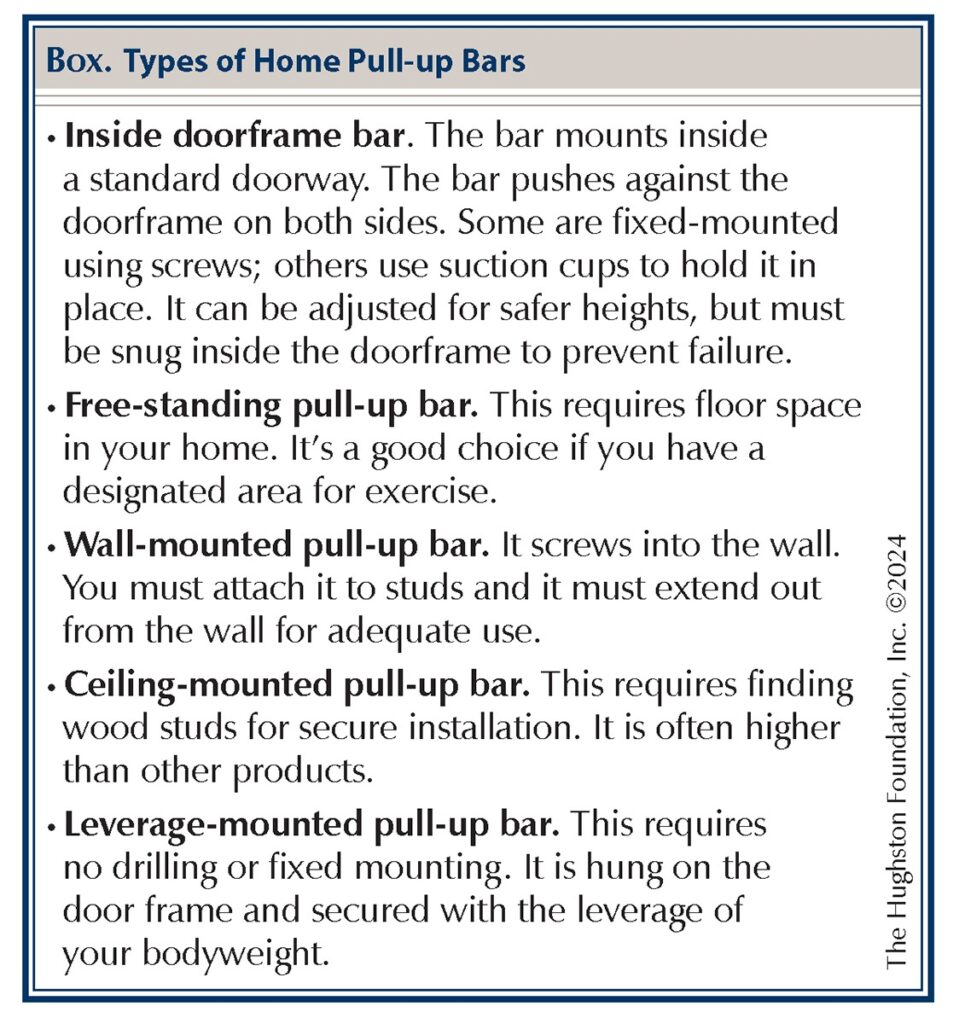
 Pull-up bars have become an increasingly popular piece of exercise equipment, as they offer easy access to strength training for the entire upper body. There are numerous products on the market for home use with a variety of installation options including freestanding, mounted within a door-frame, and wall or ceiling mounted (Box). While the benefits of pull-up exercises to one’s overall health are numerous, poor installation, improper usage, and not maintaining the equipment can lead to serious injury.
Pull-up bars have become an increasingly popular piece of exercise equipment, as they offer easy access to strength training for the entire upper body. There are numerous products on the market for home use with a variety of installation options including freestanding, mounted within a door-frame, and wall or ceiling mounted (Box). While the benefits of pull-up exercises to one’s overall health are numerous, poor installation, improper usage, and not maintaining the equipment can lead to serious injury.
Hughston research
Hughston research fellows recently analyzed injuries seen in emergency departments associated with pull-up bar use. The aim of this retrospective study (data collection using patients’ history) was to assess the population most at risk for injury when using pull-up bar exercise equipment and to identify the most common cause for these injuries.
Data collection
The research team completed a retrospective study using the National Electronic Injury Surveillance System (NEISS) database of the Consumer Product Safety Commission (CPSC) which collects consumer product-related injuries presenting to emergency departments in approximately 100 hospitals across the United States. Trained data coordinators collect NEISS records at participating healthcare centers and researchers use the data extensively in the examination of orthopaedic injury trends and patterns associated with sports and exercise equipment.1-5 The database provides statistically valid sampling weights that are representative of national estimates of these injuries.
Results of their study
Demographically, pull-up bar related injuries were more common in males (74.3%), and the highest incidence of cases was reported in ages 19 to 44 (50.4%) followed by patients less than 18 years old (36.0%). Additionally, pull-up bar injuries were 1.5 times more likely to occur in a “home” setting rather than “places of recreation.” Equipment malfunction was responsible for 20.6% of the injuries. Most reported injuries included sprains, strains, and contusions; however, there were 566 weighted cases (a statistical estimate) of fracture due to pull-up bar injuries.
What causes the injuries?
The mechanisms of injury can include improper technique, overuse, or not being physically able to safely perform the exercise. A sprain involves stretching or tearing a ligament while a strain results from stretching or tearing a muscle or tendon. Both injuries can lead to pain and swelling with healing time dependent on the severity.
Using an improper form or doing too many pull-ups too soon can lead to pain or injury, as well. Straining the neck or excessive pulling on the bar, such as with kipping, can not only lead to injury from improper technique but also cause equipment malfunction. Other injuries may be caused by twisting or bending of the neck and back, as well as direct blows to the top of the head. Damage from falling equipment can cause compressive forces through the head and neck causing injury to the spine and soft tissues. A herniated disc is another injury that can result from a fall. Further, a fractured vertebra from a fall can cause debilitating pain that requires immediate medical attention. Numbness, tingling, or loss of feeling in your hands, fingers, feet, or toes, back pain, or pressure in the neck, head, or back can be a sign of a serious injury. If you experience these types of symptoms after a fall, your physician or an orthopaedic spine specialist should evaluate your injury. Numbness or paralysis can happen quickly or can come on gradually; therefore, the time between injury and treatment is critical.
Home exercise equipment and doorframes
Pull-up bar injuries from equipment malfunction or poor installation were 11 times more likely to occur in the “home” setting in comparison to places of recreation (gyms, playgrounds, etc.) Proper installation of pull-up bars to create a safe exercise location can be challenging. For those that require door frame installation, most product manufacturers recommend a thorough inspection of the doorframe prior to using the pull-up bar. Additionally, factors such as the composition, age, and whether the doorframe is glued or nailed into the wall can dramatically alter the amount of weight the doorframe is able to safely hold.2
Follow instructions and lower the bar
Though there are risks of at-home pull-up bar installation and use, the risk of injuries can be decreased by carefully following the installation recommendations in the product’s user guide. Most user guides will recommend that you inspect the bar for damage or for parts that may have worked their way loose before beginning your exercise routine. You should always follow the recommended weight limit for the pull-bar and only use the bar as intended. Padding may be placed under the bar is for additional protection. With attention to equipment instruction and proper technique, you can reduce your risk of a serious injury while getting all the health benefits of at home pull-up bars in your strength training routine.
Author: Libby Carlino, MD, and Chad Evans, MD | Columbus, GA
References:
- Graves JM, Iyer KR, Willis MM, Ebel BE, Rivara FP, Vavilala MS. Emergency department-reported injuries associated with mechanical home exercise equipment in the USA. Injury Prevention. 2014;20(4):281-5.
- NET, WCMA. “Will a Pull up Bar Break My Door Frame?” WCMA NET, 16 Sept. 2021, www.wcmanet.org/doorway-pull-up-bar-damage/Last accessed January 2024.
- Holdsworth, FW. “Fractures, dislocations, and fracture-dislocations of the spine.” Journal of Bone and Joint Surgery, British. 1963;45(1):6-20
- Faigenbaum A, Westcott W. Youth strength training. Champaign, IL: Human Kinetics; 2009:139-165.
- Faigenbaum AD, Myer GD. Resistance training among young athletes: safety, efficacy and injury prevention effects. British Journal of Sports Medicine. 2010;44(1):56-63.
Last edited on March 19, 2024